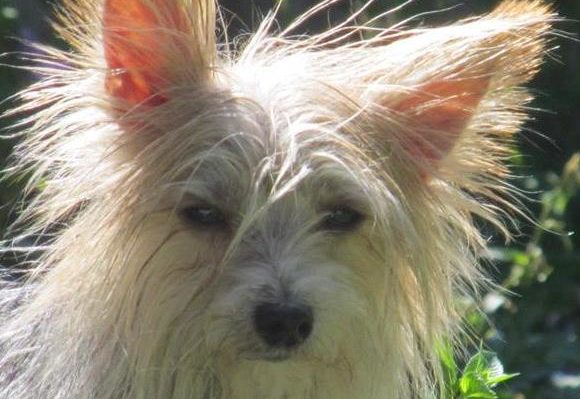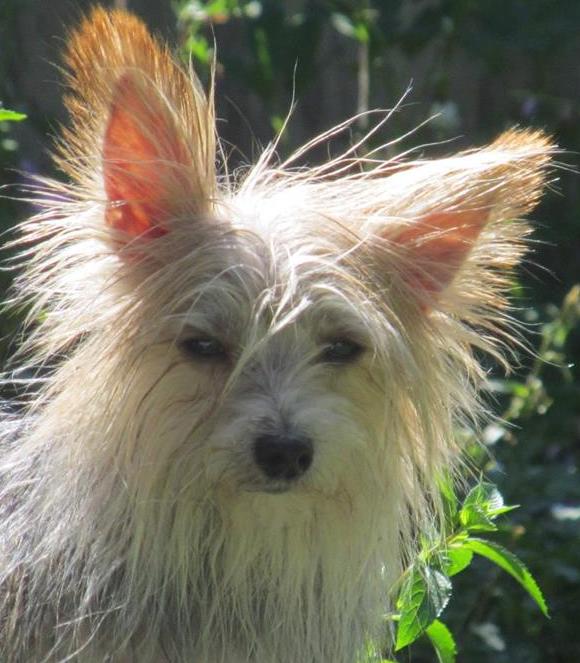
Last week, I explained that my senior dog, now 15 years old, was losing some sight and hearing. Trainers chimed in with their suggestions on how to deal with dogs of any age that have lost or are losing vision and/or hearing. I decided to take one of their suggestions and work on it.
I want to teach my younger dog to “go get” my older dog.
I want him to find her in the house or yard.
I want him to alert her and I want her to follow him to me.
That last part—where she follows him to me—will have to wait until I train the younger dog to do the first part: go to her, wherever she is, and alert her. By alert I mean wake her if she is sleeping, in particular, but also simply get her attention so she turns to him. I am hoping that the older dog’s then choosing to follow the younger dog will come naturally. If I can reinforce it powerfully enough, it will become a default behavior for the older dog. Even if that doesn’t happen, though, I’d at least like the younger dog to tell me where the older dog is, so I can go and get her myself.
The younger dog has not specifically been taught the names of the living beings with whom he interacts. I believe he understands a number of words and phrases that are not actually commands or cues, but more like directions. “Hop up” means get up on the bed, or into the back of the car. “Off” means get off the bed, the picnic table. “Kennel” means go into your kennel. Like that. They’re verbs, action words, not names.
Now I want to teach him not only a name—he needs to learn to indicate the older dog—but also an action combined with a name: go get her. I’m somewhat ambivalent at this point about those three words, in fact. I’m seriously weighing “go get her” against “go find her.” I can’t decide.

That doesn’t matter right now because the first thing I have to teach him is the name—there’s no “getting” involved at the beginning. She, the older dog, will be right here in front of him. Later, when he’s learned how to indicate her specifically when she’s only inches away, I will have to decide if I want “go get” or “go find” as a verbal cue. Right now, all I need to know is that I will use her name.
I know I want to use a clicker and treats to train this skill.
I know I will have to use the older dog as well, because how else could I do it? I couldn’t! I’ll enlist her help, but I must make the training experience as stressless as possible for her. She has been trained in the past using a clicker and treats, but it’s been a long time since her last training session—years. I’m trusting that being there while the younger dog is getting clicked and treated won’t be a big problem for her. I intend to start out with her in her small travel kennel, since it’s not possible to handle both dogs at once and I need her nearby.
In the comfortable kennel where she sleeps every night (by her own choice), I hope she can watch the process but not offer her own behaviors in hopes of treats. I might end up giving her a small stuffed Kong or some other food delight in the kennel that could take her a while to finish. As the training moves along, though, there can’t always be food in her kennel with her. That could end up being what the younger dog alerts on . . . which would defeat my goal. Of course, I have to get her out of the kennel as his training progresses, too, or he could end up alerting on the kennel instead of the older dog!
Should the older dog be uncomfortable in the kennel during the initial stages of training, I’ll have to regroup and think of another way to start. That will be true at every stage of the training. I’m training something new to all three of us, and I have no way to predict how any of us will react. I don’t want anyone stressed! I want all of us comfortable.
I might start the training with the little kennel in the place it stays whenever we’re not going somewhere in the car—in my bedroom. (The kennel is little because the older dog is little—she weighs only five pounds.) The younger dog often hangs out on the floor near the kennel. It’s a small room, with limited space for a big dog (he weighs 53 pounds). I’ll sit on the bed, he’ll sit on the floor, and the older dog will be in her little kennel, literally only a few feet away.
I will not say a cue word.
I won’t say anything.
I’ll wait for him to move.
I will click/treat movement toward the little kennel.
I’ll train for only a few minutes at a time (ending on a success), then take both dogs out of the room and probably outside to the back yard for some running around in the sun.
I’ll repeat this process as many times a day as I think I can . . . if both dogs seemed comfortable and unstressed. If either dog isn’t having a good time, I’ll reassess.
Next week, training my younger dog to “go get” (or “go find”—I don’t have to decide yet) my older dog. What’s after that? Training plans don’t have to be set in stone. In fact, the best training plans can turn out very differently from what you expected when you first had the idea. How will my plan work?



